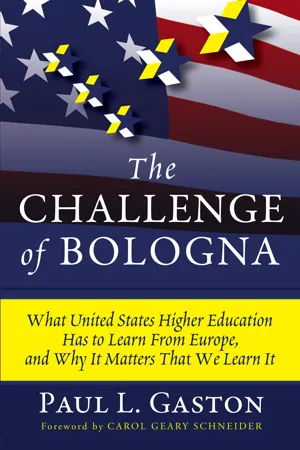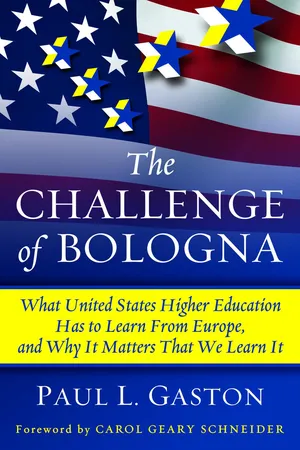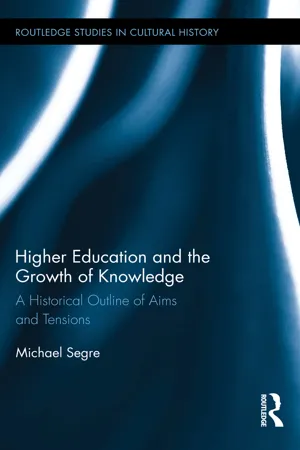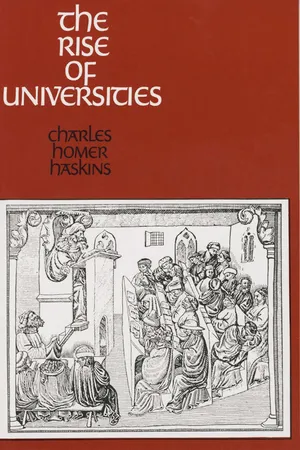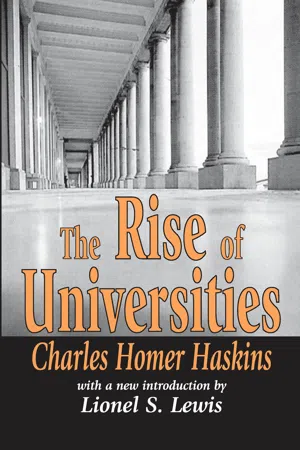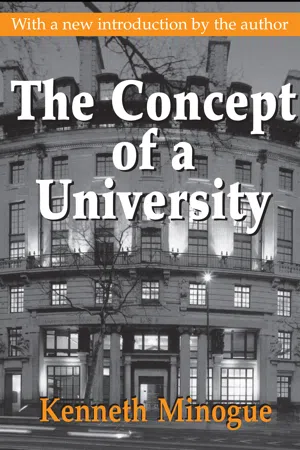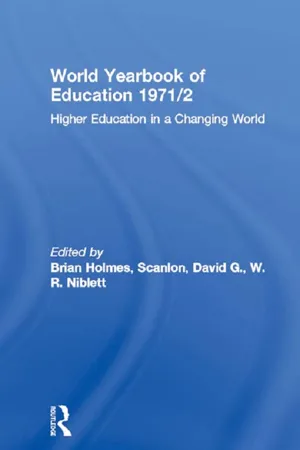History
University of Bologna
The University of Bologna, established in 1088, is considered the oldest university in the Western world. It played a significant role in the development of medieval and Renaissance legal studies and is renowned for its contributions to the field of law. The university continues to be a leading institution for academic research and education.
Written by Perlego with AI-assistance
Related key terms
8 Key excerpts on "University of Bologna"
- eBook - ePub
The Challenge of Bologna
What United States Higher Education Has to Learn from Europe, and Why It Matters That We Learn It
- Paul L. Gaston(Author)
- 2023(Publication Date)
- Routledge(Publisher)
2 THE ROAD TO BOLOGNA DOI: 10.4324/9781003447665-3 Universities, defined as multidisciplinary degree-granting academic institutions, were educating students long before there was a political entity known as Europe. As early as the ninth century, students in Morocco, Egypt, and Iraq, for instance, were convening in specific locations to study with scholars residing there. But because higher education as the world has come to know it bears most clearly the stamp of European universities founded in the second millennium, it may not be presumptuous for European education ministers to claim that “universities were born in Europe” (Sorbonne, 1998). As one historian of higher education observes, “Three springs—Salerno, Bologna, and Paris—form the headwaters of the European university” (Driver, 1971, p. 102). Of these, the University of Bologna, with a traditional founding date of 1088, is considered the oldest (Bergan, 2007, p. 19). With a particular emphasis on jurisprudence, Bologna drew students to study law with masters with whom they contracted. From these early stages, while higher education has brought opportunities for instruction and research to nearly all parts of the world, European universities have exercised a singular authority. Many of the conventions with regard to curricular structure, scheduling, the accommodation of students, the encouragement of scholarship, the provisioning of libraries, and the funding of instruction that continue to guide systems and institutions of higher education from China to Nebraska reflect European models. Most especially, as Sjur Bergan (2007) has observed, the European university introduced a qualifications framework: “A formal course of study led to a formal and certified qualification” (pp. 19-20) - eBook - ePub
The Challenge of Bologna
What United States Higher Education Has to Learn from Europe, and Why It Matters That We Learn It
- Paul L. Gaston(Author)
- 2012(Publication Date)
- Stylus Publishing(Publisher)
2
THE ROAD TO BOLOGNA
Universities, defined as multidisciplinary degree-granting academic institutions, were educating students long before there was a political entity known as Europe. As early as the ninth century, students in Morocco, Egypt, and Iraq, for instance, were convening in specific locations to study with scholars residing there. But because higher education as the world has come to know it bears most clearly the stamp of European universities founded in the second millennium, it may not be presumptuous for European education ministers to claim that “universities were born in Europe” (Sorbonne, 1998). As one historian of higher education observes, “Three springs—Salerno, Bologna, and Paris—form the headwaters of the European university” (Driver, 1971, p. 102). Of these, the University of Bologna, with a traditional founding date of 1088, is considered the oldest (Bergan, 2007, p. 19). With a particular emphasis on jurisprudence, Bologna drew students to study law with masters with whom they contracted.From these early stages, while higher education has brought opportunities for instruction and research to nearly all parts of the world, European universities have exercised a singular authority. Many of the conventions with regard to curricular structure, scheduling, the accommodation of students, the encouragement of scholarship, the provisioning of libraries, and the funding of instruction that continue to guide systems and institutions of higher education from China to Nebraska reflect European models. Most especially, as Sjur Bergan (2007) has observed, the European university introduced a qualifications framework: “A formal course of study led to a formal and certified qualification” (pp. 19–20). While the competing intellectual claims made by universities throughout the world may be formidable, such practical precedents established in Europe have remained influential. - eBook - ePub
Higher Education and the Growth of Knowledge
A Historical Outline of Aims and Tensions
- Michael Segre(Author)
- 2015(Publication Date)
- Routledge(Publisher)
studium. These associations grew slowly, surrounded by tension, not least of which that between religious and secular factions; but eventually they were recognized as “universities” by the pope, the emperor, or other local authorities. Two centers of study are considered the archetypes of the university: Bologna and Paris.At the end of the 11th century, Bologna was a focal point of conflict between the pope and the emperor, and a number of teachers of trivium began to apply themselves to the study of law, above all to the exegesis of Roman law. As Olaf Pedersen (1920–1997) remarks (Pedersen 1997 , 126), “In accordance with old Roman usage, law was viewed as part of rhetoric, and could be formally incorporated into artes liberales,” being an awareness of the utility of interdisciplinarity at this early stage. Around 1080 a manuscript of the 7th century of Justinian's Corpus Juris Civilis reached Bologna and was examined by local scholars. The pioneer in this enterprise was one Irnerius (c. 1050–1130). Afterwards, Roman law came to play a much greater role both in teaching and in politics.When was a “university,” in the sense of a guild, established in Bologna? According to Charles Haskins (1870–1937), “The students of Bologna organized such a university first as a means of protection against townspeople, for the price of rooms and necessaries rose rapidly with the crowd of new tenants and consumers, and the individual student was helpless against such profiteering” (Haskins 1975 , 9). Historian and archeologist Corrado Sicci (1858–1934), in his I primordi dello Studio di Bologna (1887), points out how difficult it is to ascertain the date of the foundation of the university. Yet poet and (later) Nobel laureate Giosuè Carducci (1835–1907), who taught at the University Bologna, suggested to celebrate the 800th anniversary in 1888, implying that 1088 was the founding year. The celebration took place in the presence of the king of Italy, Umberto I (r. 1878–1900), and Bologna became, rightly or wrongly, the first European university (Tosi 1989 , 53–111). Around 1140, Franciscus Gratianus or Gratian, probably a Camuldulensian monk (the Camuldulensian monks are part of the Benedictine family of monastic communities; their name is derived from the hermitage of Camaldoli, on the mountains of central Italy, near Arezzo in Tuscany) and the bishop of Chiusi (also in Tuscany), systematized the many ecclesiastical laws that were produced through the centuries in Concordia Discordantium Canonum (Harmony between Discordant Rules of Laws), also known as Decretum Gratiani or Decreta, conferring canon law methods and principles of the Roman law. Gratian also taught in Bologna monasteries. In 1158, a number of jurists from Bologna convinced Emperor Frederick I (Barbarossa, 1122–1190) to promulgate a constitution, Authentica Habita, which protected itinerant students from interference by any local authorities and, in particular, prohibited their being taken hostage for debts accrued by their fellow citizens. Habita also established that every school was required to constitute a societas presided over by a dominus and that students were under the jurisdiction of their teacher or of the bishop, suggesting that some kind of guild already existed in Bologna before 1158. Be that as it may, Habita - eBook - ePub
- H. Perraton(Author)
- 2014(Publication Date)
- Palgrave Macmillan(Publisher)
Part I Narrative 2 Internationalism Reshaped, 1185–1800The University of Bologna celebrated its 900th anniversary in 1988. It was a grand and colourful party with academics travelling from fellow universities to take part: academic dress may be medieval but must now be brighter than the eleventh-century norm. The date was a bit arbitrary, but had a precedent as Bologna held its 800th celebration in 1888 in the first nationalist flush of Italy’s existence as a united country. Oxford and Cambridge, founded in the late twelfth and early thirteenth centuries, were both represented and the celebrations had an international touch, with support for a proposed ‘Bologna process’ of harmonising European higher education (see Chapter 9 ). The party demonstrated not only the resilience and survival of Europe’s universities but also their sense of family. The family was reminded that students and academics, learners and teachers, have always travelled with the pattern of their journeys woven into the university fabric.The rectors and vice-chancellors of 1988 might not have recognised the medieval university if they had been transported back. Medieval students tended to be younger than their successors, some only in their mid-teens. While the threefold structure of bachelor’s, master’s and doctoral degrees was already in place, many students stayed for a year or two and never took a degree. Teaching and scholarship were organised within four faculties – arts, law, theology and medicine, sometimes accompanied by music as a fifth – in a pattern that was to survive into the nineteenth century. Oxford and Cambridge were unusual among their European contemporaries in having all four from their earliest days. There were, of course and in principle, no women.Other characteristics would have been more familiar. The American educator Clark Kerr pointed out that, of 85 institutions surviving with recognisably similar functions since 1520, 70 were universities.1 Independence is one defining feature. The medieval university already enjoyed a measure of independence from both church and state, although it served the needs of both and responded to pressure from both. Scholars enjoyed freedoms that followed from privileges granted by one or other of them. Until the Reformation monks and friars ran their own training programmes in such close – though sometimes fraught – symbiosis with Oxford and Cambridge that it is difficult to tell whether a particular activity should be attributed to the university or to one of the orders. Gradually the universities began to meet the needs of the state, as well as the church, in providing the administrators, lawyers and managers needed as state power expanded. As they did so they needed repeatedly to find ways of resolving conflicts that, too, remain recognisably similar, between the freedom and autonomy of the university and the requirements of those who provide its finance.2 - eBook - ePub
- Charles Homer Haskins(Author)
- 2013(Publication Date)
- Cornell University Press(Publisher)
licence. A Master of Arts was one qualified to teach the liberal arts; a Doctor of Laws, a certified teacher of law. And the ambitious student sought the degree and gave an inaugural lecture, even when he expressly disclaimed all intention of continuing in the teaching profession. Already we recognize at Bologna the standard academic degrees as well as the university organization and well-known officials like the rector.Other subjects of study appeared in course of time, arts, medicine, and theology, but Bologna was preeminently a school of civil law, and as such it became the model of university organization for Italy, Spain, and southern France, countries where the study of law has always had political and social as well as merely academic significance. Some of these universities became Bologna’s competitors, like Montpellier and Orleans as well as the Italian schools nearer home. Frederick II founded the University of Naples in 12 24 so that the students of his Sicilian kingdom could go to a Ghibelline school at home instead of the Guelfic centre in the North. Rival Padua was founded two years earlier as a secession from Bologna, and only in 1922, on the occasion of Padua’s seven-hundredth anniversary, I saw the ancient feud healed by the kiss of peace bestowed on Bologna’s rector amid the encores of ten thousand spectators. Padua, however, scarcely equalled Bologna in our period, even though at a later age Portia sent thither for legal authority, and though the university still shines with the glory of Galileo.In northern Europe the origin of universities must be sought at Paris, in the cathedral school of Notre-Dame. By the beginning of the twelfth century in France and the Low Countries learning was no longer confined to monasteries but had its most active centres in the schools attached to cathedrals, of which the most famous were those of Liège, Rheims, Laon, Paris, Orleans, and Chartres. The most notable of these schools of the liberal arts was probably Chartres, distinguished by a canonist like St. Ives and by famous teachers of classics and philosophy like Bernard and Thierry. As early as 991 a monk of Rheims, Richer, describes the hardships of his journey to Chartres in order to study the Aphorisms - eBook - ePub
- Charles Homer Haskins(Author)
- 2017(Publication Date)
- Routledge(Publisher)
licence. A Master of Arts was one qualified to teach the liberal arts ; a Doctor of Laws, a certified teacher of law. And the ambitious student sought the degree and gave an inaugural lecture, even when he expressly disclaimed all intention of continuing in the teaching profession. Already we recognize at Bologna the standard academic degrees as well as the university organization and well-known officials like the rector.Other subjects of study appeared in course of time, arts, medicine, and theology, but Bologna was preeminently a school of civil law, and as such it became the model of university organization for Italy, Spain, and southern France, countries where the study of law has always had political and social as well as merely academic significance. Some of these universities became Bologna’s competitors, like Montpellier and Orleans as well as the Italian schools nearer home. Frederick II founded the University of Naples in 1224 so that the students of his Sicilian kingdom could go to a Ghibelline school at home instead of the Guelfic centre in the North. Rival Padua was founded two years earlier as a secession from Bologna, and only last year, on the occasion of Padua’s seven-hundredth anniversary, I saw the ancient feud healed by the kiss of peace bestowed on Bologna’s rector amid the encores of ten thousand spectators. Padua, however, scarcely equalled Bologna in our period, even though at a later age Portia sent thither for legal authority, and though the university still shines with the glory of Galileo.In northern Europe the origin of universities must be sought at Paris, in the cathedral school of Notre-Dame. By the beginning of the twelfth century in France and the Low Countries learning was no longer confined to monasteries but had its most active centres in the schools attached to cathedrals, of which the most famous were those of Liège, Rheims, Laon, Paris, Orleans, and Chartres. The most notable of these schools of the liberal arts was probably Chartres, distinguished by a canonist like St. Ives and by famous teachers of classics and philosophy like Bernard and Thierry. As early as 991 a monk of Rheims, Richer, describes the hardships of his journey to Chartres in order to study the Aphorisms - eBook - ePub
- Kenneth Minogue(Author)
- 2017(Publication Date)
- Routledge(Publisher)
universitas, a term which might be used of any kind of legal association; towards the end of the Middle Ages it was coming to be restricted to what we now call universities. This organizational character of universities is in a number of respects just as important as their intellectual distinction, for it is here that we may find the secret of that astonishing longevity, that capacity for decay and revival which has marked the university out as distinct from any of the other scholarly institutions of other times and other civilizations. Universities were, as Rashdall puts it, ‘products of that instinct of association which swept like a great wave over the towns of Europe in the course of the eleventh and twelfth centuries’. And for several centuries, until political sovereignty began to impair their independence, they exercised the corporate freedom of feudalism to the full.Spontaneity soon gave place to artifice: in 1224 (by which time many other universities, including Oxford, were well established) Frederick II founded a studium generale in Naples, and in 1229 Pope Gregory IX did the same at Toulouse. The intention of each of these eminent founders was that the new creations should be the equals in prestige of Paris and Bologna; and in an attempt to achieve by decree what is really only susceptible to voluntary acquiescence, a Papal bull of 1233 asserted that anyone admitted to mastership at Toulouse should be allowed to teach in any other studium without further examination. The bull did not meet with universal acceptance, and the more successful studia were always suspicious of the prerogatives of other universities. Nonetheless, the granting of the ius ubique docendi came to be the distinguishing mark of universities; and founding them was recognized as the prerogative of imperial or ecclesiastical authority. By this time, their intellectual eminence gave them an important role in the life of European Christendom. Intellectually able young men of all ranks of society flocked to study at them, and many such graduates, after studying, came to occupy influential positions in the Church and the administration of realms. There were even occasions when medieval writers placed Studium as a co-ordinate power in medieval society alongside the powers of Church (Sacerdotium) and State (Regnum). - eBook - ePub
World Yearbook of Education 1971/2
Higher Education in a Changing World
- Brian Holmes, David G. Scanlon, W.R. Niblett, Brian Holmes, David G. Scanlon, W.R. Niblett(Authors)
- 2013(Publication Date)
- Routledge(Publisher)
Iustiarius, and they, in turn, chose teachers, watched over church discipline, and conferred degrees. A political class in Naples was formed in the university; this fact, of course, did not prevent the University of Naples from enjoying its moments of tension, freedom and autonomy: above all it defended the objective character of science against the character of a professional training which more and more the government tended to assign to it. Subsequently it became a stronghold of liberalism, and it could claim among its teachers such names as Francesco De Sanctis, Bertrando Spaventa, Pasquale Stanislao Mancini, Antonio Scialoja, Giuseppe Pisanelli, Angelo Camillo De Meis and Luigi Zuppetta.As we said, Naples was an isolated case. The other universities were created after the famous Bologna, which attracted scholars from all European countries. The oldest legislative bill is the autentica of Frederick I (1158 Dieta di Roncaglia) by which he recognized the legal existence of the school as a corporation. From then on in its statutes the township of Bologna ratified privileges on behalf of the university, and imposed on students and professors an oath to prevent them from moving elsewhere. The penalty was severe. Such an imposition was not welcomed by the corporation, which referred to Pope Honorious III in order to have it repealed. However, this act was ominous. In fact, another Bulla of 28 June 1219 forbade public teaching by lecturers who had not obtained the necessary authorization. This was given only to teachers who professed to holding strictly orthodox views.But the sense of freedom was strong, and defeated the threat.National Groups
The guilds strengthened their unity further by organizing themselves into national groups (according to the student's birthplace), which elected in turn the Rector, thus providing the university with a more solid basis. Among these groups the Italians, Provençals, French and Germans were the most prominent. All the Italian provinces were represented and up to thirteen nations among the Ultramontanes could be counted.Students elected the Rector (who has been called Magnifico since the fifteenth century). The Rector had full legal academic authority, and was in office for one year. However, his position was rector scholarium, not studii, and he had to have been a student of law for at least the last five years, unmarried, a layman and with independent means. The professors were rectores studii.
Index pages curate the most relevant extracts from our library of academic textbooks. They’ve been created using an in-house natural language model (NLM), each adding context and meaning to key research topics.
